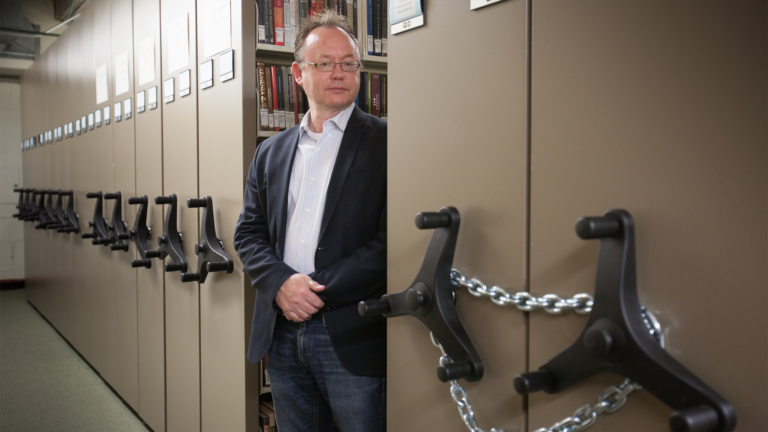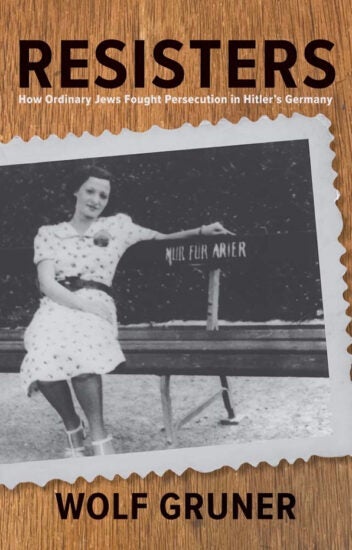
From witnessing oppression to investigating resistance
Wolf Gruner understands oppression. Born in East Berlin mere months before construction of the infamous wall that would divide the city for the next three decades, he grew up behind the Iron Curtain.
Over the years, he witnessed the oppression of political dissidents and experienced discrimination against artists critical of the state. As one of them, he wrote poems and stories and came to detest how the government used persecution as a political tool.
He also experienced racism: His first romantic interest was a woman who was half Vietnamese and often bore the brunt of racist insults. Revolted by the attacks, Gruner began to grow curious about the motivation behind them and decided to study history. As a student at Berlin’s Humboldt University, he wondered how racism might play a role in mass violence such as the Holocaust.
With the fall of the Berlin Wall in 1989, only months after he earned his history diploma, Gruner gained newfound freedom in his homeland, including intellectual liberation. Now he was able to pursue PhD studies investigating forced Jewish labor outside of concentration camps during World War II, the topic of his prizewinning thesis.

Gruner’s passion for understanding the Nazi persecution of the Jews led him to author 10 books on the Holocaust. Topics ranged from the overlooked role of German city governments in instigating anti-Jewish policies to, most recently, uncovering widespread and wide-ranging individual resistance by Jewish men and women in Nazi Germany.
His prolific writing and insight have made a significant mark in the field. “The volume of Wolf’s authored and co-edited books is breathtaking,” said Björn Krondorfer, a Holocaust, genocide and human rights scholar at Northern Arizona University. “Each explores new aspects related to Holocaust history, expanding not only our historical knowledge but also our conceptual thinking.”
Over time, Gruner’s scholarly lens widened. He began investigating other instances of genocide and mass violence around the world. In his research, he noted brutal similarities, from the systematic discrimination and repressive policies against the Indigenous majority in postcolonial Bolivia or the Armenian genocide in the Ottoman Empire. Recognizing these parallels pushed Gruner’s research into the field of comparative genocide and examining potential ways to thwart mass violence.
“I started to become more and more interested in how people actually react to mass violence and the forms of resistance that exist,” says Gruner, the Shapell-Guerin Chair in Jewish Studies and professor of history at the USC Dornsife College of Letters, Arts and Sciences.
Gruner’s commitment to scholarly exploration is just as strong today: He is the founding director of the USC Dornsife Center for Advanced Genocide Research (CAGR), one of the world’s leading institutions studying the Holocaust and other historic acts of genocide. Under Gruner’s dynamic leadership, CAGR, which marks its 10th anniversary this year, continues to focus on and build understanding of the origins, dynamics and consequences of mass violence throughout history.
Origins of the Center for Advanced Genocide Research
Gruner arrived at USC from Berlin in 2008, tasked with creating a Holocaust program at the university. Quietly, however, he held an even more ambitious plan: to establish a scholarly center investigating the Holocaust and other genocides side by side. He believed that an interdisciplinary center would provide rich insights into the origins of mass violence and how to prevent it.
In 2010, he won a competitive three-year grant from USC Dornsife to create a research cluster aligned with his vision. The resulting Resistance to Genocide program — a precursor to CAGR — organized annual international conferences and hosted a speaker series featuring international genocide studies scholars.
“It was clear to me this type of comparative study was critical and valuable,” says Gruner. “There was much to be learned about the origins of and opposition to genocide as we crossed disciplines, geographies and contexts.”
Gruner’s early years at USC also included developing academic programming alongside USC Shoah Foundation — The Institute for Visual History and Education, which spotlights the personal stories of survivors and witnesses of the Holocaust. In 2013, Gruner approached USC Shoah Foundation leadership about transforming his existing research cluster into a more robust center.
Gruner’s artful lobbying sparked financial support from the foundation, and CAGR was born.
CAGR’s active community grows
Immediately, Gruner began building CAGR as something distinctive — an interdisciplinary, research-driven center focused on studying historical incidents of mass violence.
He started by carefully selecting staff, including CAGR Deputy Director Martha Stroud, an anthropologist specializing in the Indonesian massacres of 1965–66. Together, Gruner and Stroud developed an internationally unique, broad portfolio of research opportunities and programming centered around innovative approaches to Holocaust and genocide studies.

CAGR now hosts six residential research fellowships each year for USC undergraduates, graduate students, international PhD candidates and senior scholars. The fellows pursue innovative work using USC’s vast Holocaust and genocide studies resources, which today include 56,000 survivor testimonies in the USC Shoah Foundation Visual History Archive, dozens of private paper collections from Nazi refugees and Jewish survivors, archives with legal settlements pertaining to the Armenian genocide and post-World War II Nazi-era trials, and about 30,000 books.
Beyond its fellowship program, CAGR organizes research workshops and an annual one-week program allowing scholars from different universities, disciplines and continents to brainstorm collaborative projects.
Every year since 2016, CAGR has organized an international conference. The center’s hallmark event has been hailed for its interdisciplinary, discussion-fueled focus and innovative topics, such as music as resistance to genocide, digital approaches to genocide studies, and the lasting impact of mass violence on Indigenous communities.
In addition, CAGR regularly presents fellow lectures, film screenings, book talks and other public events throughout the year. The center livestreams the events to an international audience, reaching South Korea, Saudi Arabia, Argentina, Germany and Israel. Currently, more than 150 events are accessible on its YouTube channel.
“These events play an important role in deepening understanding and inviting discussions around why people participate in mass violence and how they oppose it,” Gruner says.
Prizing diversity
To advance and shape the landscape of Holocaust and genocide studies — a foremost aim of CAGR — Gruner prioritizes diversity. The center designs events with international significance, academic innovation and interdisciplinarity in mind. For instance, CAGR’s 2022 international conference on the lasting impact of mass violence on Indigenous peoples featured scholars from more than 30 Indigenous communities and nearly as many academic disciplines from the Americas and the Pacific region.
“In the more recent part of his career, Wolf is applying all that he knows in the field of Holocaust studies to other minority populations and their persecutions,” said Mark Celinscak, a genocide researcher at the University of Nebraska at Omaha. “He is clearly helping scholars of genocide both inside and outside of Holocaust studies.”
“When you bring together people from different fields, it results in a particularly refreshing and enlightening scholarly exchange,” says Gruner, adding that, up to now, CAGR has hosted scholars representing 67 different academic disciplines and 53 different countries since its inception.
“What we’ve accomplished over the years is much more expansive than the typical center or program in Holocaust and genocide studies,” Gruner says. “We’ve been able to illuminate new questions, foster a growing cohort of innovative, interdisciplinary scholars, and build a global network of people committed to advancing scholarship around the Holocaust and genocide studies.”
Capturing global prominence
Over its 10 years, CAGR has developed a strong international reputation. Established and emerging scholars around the world recognize the center’s expertise and mentorship, seek out its staff for collaboration and leverage its global resources to advance their own research.
This year, CAGR hosts the conventions of two leading international organizations at USC: the International Network of Genocide Scholars and the Holocaust Educational Foundation of Northwestern University. Together, the conventions bring about 400 Holocaust and genocide scholars from around the world to Los Angeles.
In addition, Gruner — with Krondorfer, Celinscak and others — played a prominent role in forming the Consortium of Higher Education Centers for Holocaust, Genocide and Human Rights Studies, a conglomerate of more than 50 center directors advancing research and education in these fields on college campuses across the United States. He is also an appointed member of the academic advisory committee at the United States Holocaust Memorial Museum.
With CAGR now operating independently of the USC Shoah Foundation, Gruner aims to solidify the center’s future, including expanding its staff and creating long-term fellowships. Funding for those steps, he says, would strengthen CAGR’s position as a vital and globally prominent research center for Holocaust and genocide scholarship, a dual study Gruner considers crucial to combatting mass violence and highlighting possibilities of resistance.
“All over the world today, there is systematic mass violence against groups that societies have labeled as ‘others,’” Gruner says. “By understanding the historic causes of mass violence, beyond simplistic explanations of hate as the sole driving force, we can find new approaches to slow these processes and enact positive interventions.”